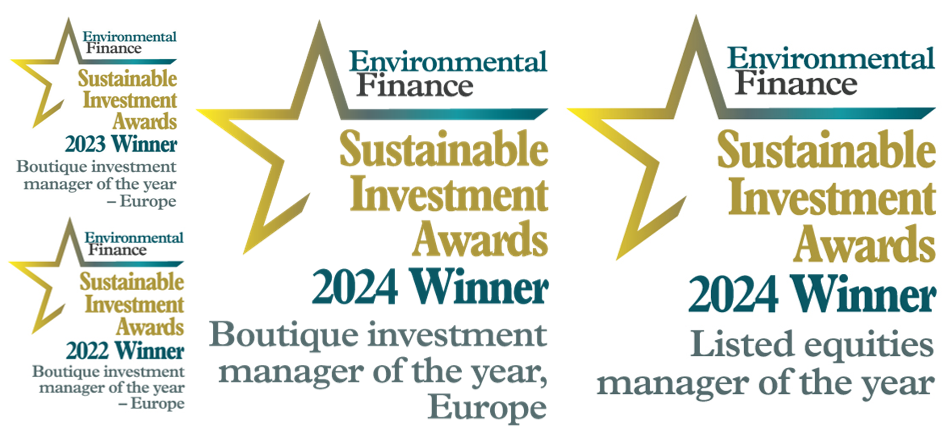We are deIighted to win the Boutique Investment Manager of the Year Award for the third consecutive year!

NB: The Environmental Finance Sustainable Investment Awards are free to applicants and open to all organisations globally. These awards were given June 2022, June 2023 and June 28 2024, and relate to the annual periods May 21 – May 22, May 22 – May 23, and May 23 – May 24, respectively. Environmental Finance independently provided Osmosis with a questionnaire to be used in the preparation of the third-party rating or award.
Write up from Environmental Finance
For the third year running Osmosis Investment Management (IM) has taken the Boutique investment manager of the year – Europe for its track record of delivering better risk-adjusted returns versus the MSCI World.
This performance led, over the last year, to a 70% increase in assets under management (AUM) to $15.9 billion, including $70 million from a Korean pension fund following the firm’s expansion into the Asian region, as well as $250 million from a UK local authority.
The asset manager puts its success down to its quantitative investment approach, which measures a company on its sustainable actions rather than just its targets or well-meaning intentions. It believes that those companies that have effectively monetised sustainability to the balance sheet will outperform their sector peers over the long term.
Looking beyond just carbon reduction, Osmosis’s strategies comprises comprise three levels of environmental impact. The multi-environmental factor-based approach results in a reduction in the ownership of carbon (-54%), water (-69%), and waste (-67%) relative to the MSCI World.
“A strong performance coupled with innovative technology and processes to drive repeatable and resilient investment performance,” commented one Environmental Finance Awards judge, adding that “active ownership and cost transparency stands out.”
Another applauded the asset manager’s “constructive inflows which ensures that narrative is efficient and compelling”.
Ben Dear – CEO & Founder of Osmosis

“Winning these awards is a testament to our 14-year commitment and dedication to try and address the complex challenges investors face when addressing the environmental footprints of their portfolios. It reflects the thoughtful approach we have taken to build innovative strategies that mitigate portfolio environmental risks while targeting financial returns, and it’s made possible by our clients, in 14 countries, who’ve fuelled our growth to ~$16 billion in AUM.”
Osmosis also picked up the Listed Equities Manager of the Year award. The team identified early on that Resource Efficiency was a return signal independent from traditional country, sector, size and style factors. As a result, their strategies have been used to enhance investment portfolios without impacting existing exposures.
2023 continued to be a year of research as it completed a project into corporate environmental data in emerging markets, claiming to acquire more than double the number of carbon data points in emerging markets than some well-known third-party data providers.
It is also confident that its extensive water and waste data points give it a leading edge compared to the peer group, especially as companies and investors tend to overlook this data due to a focus on carbon.
Active ownership is another key part of Osmosis’s outlook and throughout 2023 it engaged with 324 companies and voted on 10,917 proposals in order to promote better environmental disclosure. It, in turn, believes this leads to investment in companies more likely to manage, measure and reduce their environmental impact.
About Osmosis
A unique sustainable factor based on Resource Efficiency
Identification of a sustainable alpha signal is a challenge solved by only a few in the ESG space.
The Resource Efficient Core Equity Fund launched following extensive research, correlation and attribution analysis on our proprietary Resource Efficiency Factor. Developed over 14 years, our proprietary and objective environmental research process enables the identification of those companies that are better placed to deal with the increasing number of environmental challenges that lie ahead. At the same time, those companies that refuse to change or are too slow to adapt will continue to destroy shareholder value.
Managing active & environmental risk
All portfolios seeking a sustainable outcome will naturally bring in active risk relative to a market-cap-weighted benchmark. The Osmosis program is unique in that the active risk is controlled and targeted towards a sustainable alpha signal.
Our goal was to ensure that when investors seek to reduce their portfolio’s environmental footprints, the risk that they assume is not left unrewarded. Our core strategies aim to deliver better risk-adjusted returns than the respective benchmarks by tilting the portfolio towards stocks we have identified as more resource-efficient and thus more likely to outperform their sector peers. All the strategies deliver the main benefits of index investing by offering a highly diversified and cost-efficient portfolio.
Research has evidenced that Resource Efficiency is a return signal independent from traditional country, sector, size and style factors. The allocated risk budget is targeted towards resource efficiency through the idiosyncratic part of the risk models, risk that is usually diversified away. Through this smarter management of the active risk, the core strategy can replace the MSCI World without impacting existing exposures and enhancing the risk-adjusted return.
A broad economy approach
When we launched in 2009, we were the first sustainable asset manager to focus on a broad economy solution. We recognised that addressing supply was only meaningful in the context of addressing demand. This Fund was developed to appeal to investors from institutions to individuals who shared our conviction that a well-diversified global portfolio, targeting overweight and underweight positions to environmentally efficient and inefficient companies across the broader economy, would result in improved portfolio returns.
A significant environmental impact
The outcome of this sophisticated core replacement strategy is a significant reduction in the portfolio’s environmental footprint. The strategy delivers significant reductions in ownership of Carbon (55%), Water (69%) and Waste (69%) (as of 31 March 24) relative to the benchmark while remaining invested across the broader economy*.
Osmosis believes that the planet’s long-term sustainability demands a re-evaluation of overall resource consumption. Carbon, Water and Waste, are each subject to increasing regulation, cost pressure and social scrutiny. Companies focused on environmental impact need to address those aspects of consumption and pollution that are most relevant to their business model, which will often include the mitigation of resources other than Carbon. Osmosis’ research demonstrates that this three-factor approach also delivers a more reliable investment signal.
Important Information
Osmosis Investment Management UK Ltd (“OIM UK”) is an affiliate of Osmosis Investment Management US LLC (“OIM US”). Osmosis Investment Management AUM includes discretionary assets under management of OIM US and OIM UK and assets invested in model programs provided by OIM US and OIM UK.
The MSCI World Index captures large and midcap representation across 23 Developed Markets. With 1,464 constituents, the index covers approximately 85% of the free float-adjusted market capitalization in each country.
ESG Criteria
Environmental, Social, and Governance (“ESG”) criteria are incorporated into the portfolio construction of all Osmosis’s products. Utilising ESG as an investment factor has risks including that it may not encompass all environmental, social, or governance issues, and as with all investment approaches, there are no guarantees that it will lead to greater portfolio performance.
For more information on the Osmosis approach to ESG, please see our separate ESG disclosures.
* The foot printing metrics above have been calculated using a Total Metrics approach, apportioning carbon emissions, water consumption and waste generation to the investor based on an equity ownership perspective. Calculating the “owned” emissions, water and waste from each position in the portfolio and benchmark, and adding those metrics yields the total impacts for the portfolio. The calculations have been based on metrics recorded in the MoRE DataBase where available, and industry averages have been used to estimate any gaps in the data coverage.



